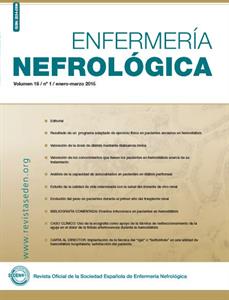Contenido del artículo principal
Resumen
Los pacientes sometidos a hemodiálisis periódica presentan una inmunidad deprimida con mayor susceptibilidad a contraer infecciones. Esta vulnerabilidad se incrementa por la necesidad de acceder a su torrente circulatorio y los intervalos de circulación extracorpórea, lo que puede facilitar la infección por microorganismo. Las infecciones, solo precedidas por los eventos cardiovasculares, representan en los pacientes en hemodiálisis la segunda causa de muerte, con una mortalidad atribuible del 14%, siendo las infecciones de los accesos vasculares la primera causa de bacteriemia1-3. Es imprescindible una vigilancia epidemiológica de los eventos infecciosos y de las resistencias antibióticas de estos pacientes para implementar planes de mejora que incluyan actividades de prevención y control. Los Centers for Disease and Controlde los Estados Unidos, desde 1999 llevan a cabo un sistema de vigilancia epidemiológica en hemodiálisis conocido como Dialysis Surveillance Network. Más recientemente, se ha creado el National Healthcare Safety Network con similares objetivos. En Europa existen sistemas multicéntricos que han publicado guías, indicadores y recomendaciones destinadas a minimizar el impacto de las infecciones en el paciente renal. El tipo de acceso vascular influye directamente en el riesgo de presentar episodios infecciosos y representa el factor de riesgo más importante en el desarrollo para bacteriemias e infecciones; es de menor riesgo en las fístulas arteriovenosas, seguidas de las prótesis endovasculares, los catéteres tunelizados y los catéteres no tunelizados2. Aunque ciertos factores de riesgo, como las transfusiones o los trasplantes, pueden ser responsables de la infección por virus en los pacientes con enfermedad renal crónica, diversas evidencias indican que puede producirse una transmisión entre pacientes por contacto físico con las superficies externas del equipo de diálisis, de forma directa o a través de las manos del personal que lo manipula2. Entre todos los gérmenes destacan los virus transmitidos por la sangre humana, en particular, los virus de la hepatitis B y de la hepatitis C1. Respecto al tratamiento para combatir a los gérmenes se hace evidente la necesidad de ajustar las dosis y evitar las resistencias a los mismos. En infecciones agudas como las respiratorias, un tratamiento empírico con vancomicina sin cultivo previo suele ser de elección por su efectividad y tolerancia, aunque el uso de otros fármacos es motivo de constante investigación.
Palabras clave
Detalles del artículo
Aviso de derechos de autor/a
© Los autores ceden de forma no exclusiva los derechos de explotación de los trabajos publicados y consiente en que su uso y distribución se realice con la Licencia Creative Commons Atribución - No comercial 4.0 Internacional (CC BY-NC 4.0). Puede consultar desde aquí la versión informativa y el texto legal de la licencia. Esta circunstancia ha de hacerse constar expresamente de esta forma cuando sea necesario.




